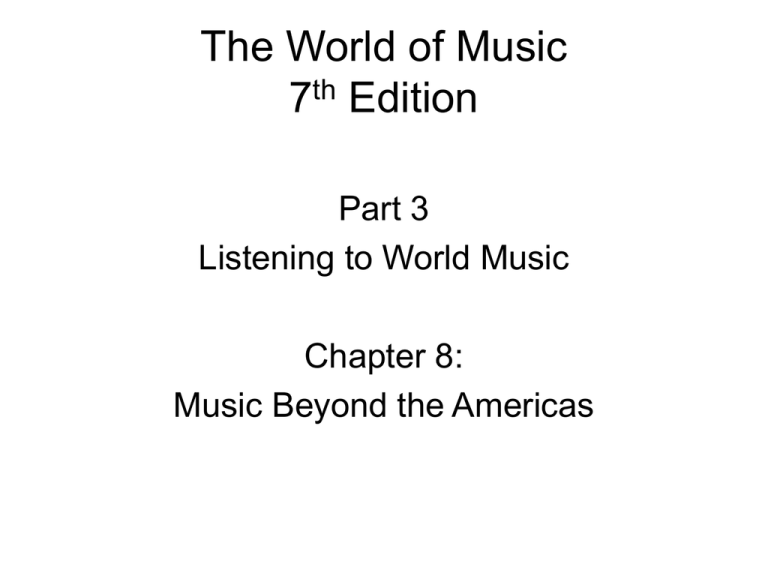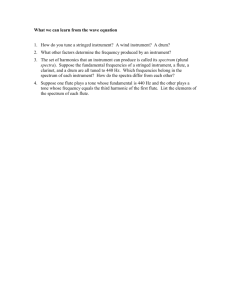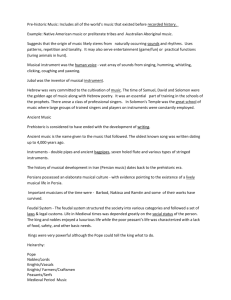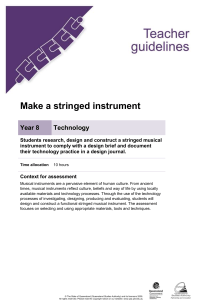The World of Music 7th Edition
advertisement

The World of Music 7th Edition Part 3 Listening to World Music Chapter 8: Music Beyond the Americas Classical Music of India • Classical Music – – – – – – – Highly Developed Improvisatory Melodic No Intended Harmony Memorized Virtuosic Sensitive • Terms – – – – Rasa - the aesthetic basis Raga – the melodic pattern Tala – the rhythmic pattern Guru – master teacher • Hindustani Instruments – Sitar – the lead plucked stringed instrument – Sarod – another plucked stringed instrument – Tabla - drum – Tambura – stringed instrument providing the drone • Karnatic Instruments – Vina - the lead plucked stringed instrument – Mridangam - drum – Sarangi – a bowed stringed instrument Popular Music of India • • • • Disseminated by Cassette Tape Often Pirated Influenced by Western Jazz and Rock Often Lip-Synched in “Bollywood” Musicals Music in Japan • Traditional Japanese Music – – – – – Often incorporated into theatre Regional in Variety Entwined with visual and dramatic effects Maximum Effect from Minimum Resources Kengyo – Venerable Master Teachers • Instruments – Koto – 13 stringed instrument – Shakuhachi – End Blown Flute – Shamisen – 3 stringed accompaniment instrument Music in Japan • Styles – Gaguku – ancient court music • From 9th through 11th centuries • Total experience – dance, masks, visual effects • Instruments – Hichiriki – Double reeded like an Oboe – Sho – Mouth Organ – Kabuki – theatrical music • After the 14th century • Naguta – the onstage ensemble – Drums, Shamisens, Flute, and singers • Geza – Offstage ensemble primarily for effects Music in Japan • Western Styles Prominent – Taught in Schools, Universities, and conservatories • Classical • Jazz • Latin – Performed Frequently Music in Sub-Saharan Africa • Usually found with other Arts – – – – – Dancing Cotumes Sculpture Crafts Drama • Functions – – – – Religious Social Activities Entertainment Ceremonies • Instruments – Membranophones • Drums – Idiophones • Rattles • Bells – Chordophones • Harps • Fiddles – Xylophones – Mbiras (Thumb Piano) • 8 to 30 keys/metal reeds – Aerophones • Trumpets • Flutes Popular Music in Sub-Saharan Africa • Famous Styles – Highlife – Juju – Afro-Beat • Influenced by Western Popular Music • Famous Artists – – – – Babtunde Olatunji Youssou N’Dour King Sunny Ade’ Ladysmith Black Mambazo Traditional Music of Eastern Europe • Influences – Byzantine Chants – Mongolian Pentatonic Modes – Islamic Rhythms/Textures – Western European Musical Language • Threats to Traditional Music – Shift to Industrialization – Government Control of Culture – Changes in National/Regional Boundaries – Ethnic Population Shifts The Music of Indonesia • Gamelan – 4 to 30 musicians – Instruments • Gongs • Drums • Metal “Xylophones” – Often with added Dance, Drama and Poetry – Non-Western Scales – Found in many American Universities (FSU) • Popular Music – Kroncong • • • • Old Style From Film Patriotic Respectable – Dangdut • Youth (New) Style • Mostly poor people • Influences from – Indian Music – Kroncong – Western Pop Jewish Music • American Jewish Classical Composers – – – – Irving Berlin George Gershwin Aaron Copland Leonard Bernstein • Liturgical Music – Emphasizes prayers and invocations – Melismatic – Sung by the Cantor • Klezmer Music – Popular – Small Band (Combo) – Plays • Jewish Tunes • Yiddish Folk Music • Gentile Music Celtic Music • Traditional Music found in – – – – – – Ireland Scotland Wales Brittany (GB) France Spain • Oral Tradition • Popular amongst New Age Music Fans • Similar to, but not equal to Irish Folk Music • Artists – – – – Altan Clannad Solas The Chieftains Celtic Music • Instruments – Fiddles – Bodhran • Hand Drum – Harp • Celtic • Welsh – Bouzouki • Plucked Stringed Instrument – Uilleann Pipes • Irish Bellows blown Bagpipes – Hurdy Gurdy – a mechanical violin • A stringed instrument where a rosined wheel rotates under the strings (instead of being bowed) creating the vibrations for sound




![History of Stringed Instruments[1]](http://s2.studylib.net/store/data/005707415_1-12ec8f4b44824912a5e4c3c8d559fe82-300x300.png)


